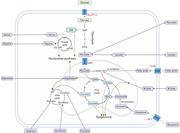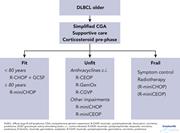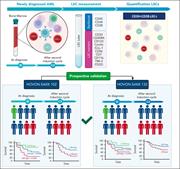Issue Archive
Table of Contents
BLOOD COMMENTARIES
REVIEW ARTICLE
Metabolism in stem cell–driven leukemia: parallels between hematopoiesis and immunity
Rattigan and colleagues examine the current understanding of the role of metabolism in proliferation and survival of cancer cells. The authors review the multiple metabolic pathways beyond the “Warburg effect” that impinge on and are modified by leukemia cells. They discuss the degree with which these pathways are shared with normal hematopoietic stem cells and investigate the challenge to discover safe entry points for exploiting metabolic dependence to promote successful therapy without negatively affecting normal hematopoietic stem cells and immune cells.
HOW I TREAT
How I treat older patients with DLBCL in the frontline setting
Using 2 illustrative cases, Lugtenburg and Mutsaers review their approach to diffuse large B-cell lymphoma (DLBCL) in older patients. DLBCL is curable but occurs commonly in older individuals with other medical issues that may be an impediment to chemotherapy. Based on a simplified geriatric assessment, the authors discuss the role of full-dose therapy with cytokine support, lower dose therapy, and supportive care in the management of these patients.
CLINICAL TRIALS AND OBSERVATIONS
Concurrent pembrolizumab with AVD for untreated classic Hodgkin lymphoma
Clinical Trials & Observations
Lynch et al report on a single-arm study of concurrent pembrolizumab with doxorubicin, vinblastine, and dacarbazine (AVD) in 30 patients with untreated classic Hodgkin lymphoma (uCHL). Complete remission was documented in 90% of patients, and 2-year progression-free survival and overall survival were 97% and 100% respectively. Interestingly, circulating tumor DNA (ctDNA) appears to be a better predictor of outcome than positron emission tomography/computed tomography (PET-CT); of 4 patients with positive PET-CT and negative ctDNA at the end of therapy, none have relapsed. Though preliminary, concurrent PD-1 inhibition plus chemotherapy is a promising therapy for previously uCHL.
IMMUNOBIOLOGY AND IMMUNOTHERAPY
Selective homing of CAR-CIK cells to the bone marrow niche enhances control of the acute myeloid leukemia burden
Chimeric antigen receptor (CAR) T-cell therapy for acute myeloid leukemia has been disappointing, partially reflecting poor targeting of leukemic stem cells in the bone marrow. Seeking to overcome this, Biondi et al expressed the homing receptor CXCR4 in CD33.CAR-cytokine induced killer cells (CIKs) and improved chemotaxis to the bone marrow and increased antileukemic activity. However, expression of the mutant CXCR4 variant associated with WHIM (warts, hypogammaglobulinemia, infections, myelokathexis) syndrome, in which cells are retained in the marrow and display increased homing, did not increase antileukemic efficacy as had been hypothesized, suggesting that CXCR4 acts to amplify killing by another mechanism.
LYMPHOID NEOPLASIA
Ubiquitin receptor PSMD4/Rpn10 is a novel therapeutic target in multiple myeloma
Targeting the immune microenvironment in Waldenström macroglobulinemia via halting the CD40/CD40-ligand axis
There is increasing attention focused on the immune microenvironment of lymphoid malignancies that appears to protect tumor cells from immune attack. Sacco and colleagues address this question in Waldenström macroglobulinemia (WM). Transcriptomic profiling in a murine model of WM with confirmation in patient samples demonstrated increased regulatory T (Treg) cells with a characteristic signature that is induced and expanded in WM. The authors further identified crosstalk between WM cells and Tregs supported by CD40/CD40 ligand, identifying a potential clinical target for inhibiting WM growth.
PLATELETS AND THROMBOPOIESIS
TRANSFUSION MEDICINE
Prior immunization against an intracellular antigen enhances subsequent red blood cell alloimmunization in mice
The reason why only some patients are predisposed to red blood cell (RBC) alloimmunization with transfusion is unknown. Jajosky et al present intriguing observations that suggest that predisposition to alloimmunization may reflect priming of the immune system by exposure to intracellular antigens that increase the alloimmune response to unrelated RBC surface antigens. No specific antigen has been identified, and it remains to be assessed whether this is a response to a specific antigen or is rather a reflection of an overall immune dysregulation that predisposes susceptibility of priming to an array of intercellular antigens.
LETTERS TO BLOOD
Prospective validation of the prognostic relevance of CD34+CD38– AML stem cell frequency in the HOVON-SAKK132 trial
Clinical Trials & Observations
BLOOD WORK
-
Cover Image
Cover Image
![issue cover]()
Filamin (green) is delocalized from vinculin (red) in 1-hour-spreading cells. Merged confocal sections of enhanced green fluorescent protein–filamin wild type were fixed after plating on fibronectin-coated glass for 1 hour. Such delocalization is consistent with the model where filamin-bound integrin α cytoplasmic tail (CT) is widely separated from β CT–linked focal adhesion complexes containing vinculin. See the article by Liu et al on page 2629.
- PDF Icon Front MatterFront Matter
- PDF Icon Table of ContentsTable of Contents
- PDF Icon Back MatterBack Matter
- PDF Icon Editorial BoardEditorial Board
Advertisement intended for health care professionals
Email alerts
Advertisement intended for health care professionals












The next frontier: enter PD-1 and exit PET scans?
Clinical Trials & Observations